WHAT DO COMPANIES HAVE TO DO TO COMPLY WITH SB 219?
SB 219’s compliance requires companies to report their full carbon footprint, focusing heavily on Scope 3 emissions—indirect emissions throughout their supply chain—alongside direct emissions (Scope 1) and energy-related emissions (Scope 2). Beyond emissions, companies must assess climate-related financial risks. This includes:
- Physical risks, such as operational disruptions due to extreme weather.
- Transition risks, like increased costs from carbon regulations or shifting market demand toward greener products.
Below is our recommended strategy for your SB 219 compliance journey, from setting up cross-functional teams to leveraging tools for automated data collection and reporting. This approach will help you get started with meeting regulatory compliance.
- Assemble a Cross-Functional Team
To achieve compliance, a multi-departmental approach is important. Assemble a task force that includes experts from sustainability, legal, finance, operations, and supply chain management. They will help evaluate your current reporting framework, identify data collection gaps, and implement SB 219 requirements. - Map Your Supply Chain
Mapping your supply chain is one of the first steps when it comes to Scope 3 emissions. Partner with a supplier that can help you with this process. A robust supply chain mapping tool should encompass strong supplier collaboration features that ensure data security while streamlining the onboarding process. - Implement Data Collection Mechanisms
One of the biggest challenges in meeting SB 219’s demands is the data collection across all emission sources, especially Scope 3 emissions from suppliers. Optchain’s platform integrates with your existing systems, automating the collection and aggregation of emissions data. This automation reduces manual input, speeds up reporting, and ensures accuracy. By leveraging Optchain’s APIs, you can automatically retrieve emissions data from suppliers and logistics partners, streamlining your Scope 3 calculations. - Supplier Engagement and Collaboration
Scope 3 emissions depend on the carbon footprint of your suppliers. Engaging with them is essential. Make sure you partner with a vendor who has collaborative features allowing you to share sustainability goals and track supplier compliance. The Optchain platform offers a performance dashboard, enabling you to reward suppliers who meet emission reduction targets or penalize those who do not. These insights empower you to foster a sustainable and compliant supply chain. - Real-Time Data Reporting and Visualization
As more and more regulations get passed, get ready to prepare multiple reports. Optchain simplifies reporting by offering real-time data visualization dashboards. Our carbon-tracking tool consolidates emissions data from across your value chain and presents it in an intuitive, customizable interface. This makes it easy to generate the reports required under SB 219, and the system’s real-time updates ensure you’re always working with the most current data.




